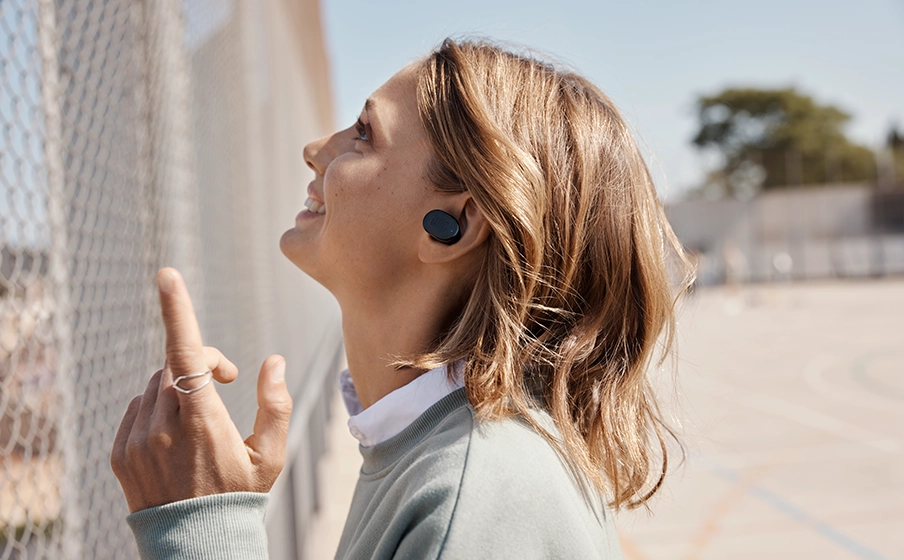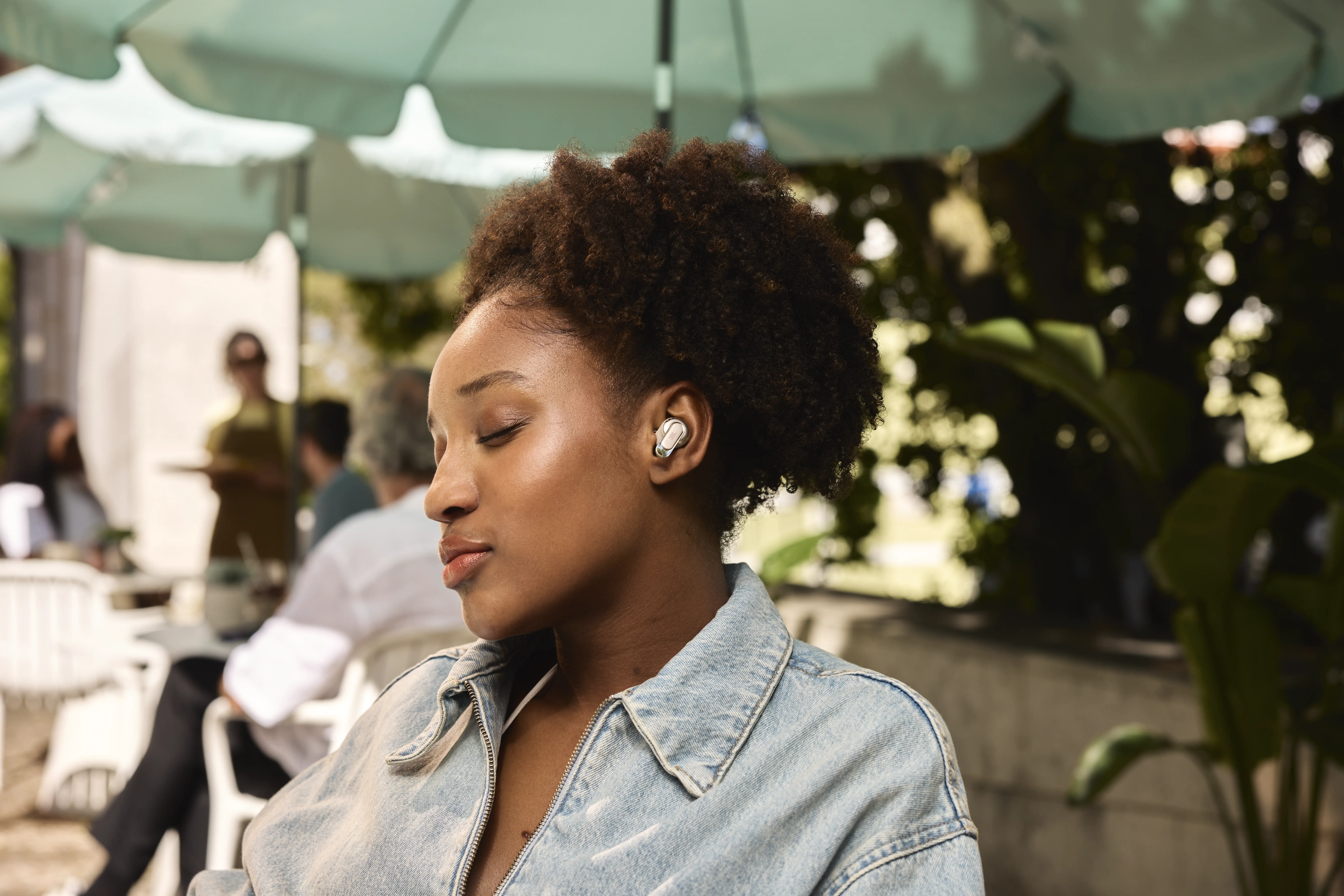How True Adaptive Noise Canceling sets the standard
STORIES
How noise-canceling technology works—from basic blocking to true adaptive genius.
Life gets loud. Sometimes, you just want to tune out—and that’s why noise canceling headphones were invented.
But when you stop to think about it, this is a weird technology we all just take for granted. How is it even possible to cancel noise? Is it dark magic? And is all noise canceling the same? This is a topic that we’re obsessed with, so this is going to get a little nerdy.
What Is Noise Cancellation?
Before we get too far into the types of noise cancellation, let’s cover some basic facts about the science of sound (don’t worry, there’s no quiz at the end).
Whether it’s a podcast, a power ballad, or heavy machinery right outside your window, sound travels through the air in waves. Those waves have peaks (high points) and troughs (low points). When two identical waves align, those waves are “in phase,” creating an even louder sound because they reinforce each other.
But when identical waves are out of phase, they interfere with one another — meaning the peaks of one wave match the troughs of another — canceling each other out.
This anti-phase science is the basis of active noise-canceling technology. The most common type of noise canceling, active noise canceling uses tiny microphones to capture the sounds around you. A small amplifier creates sound waves that are out of phase with what you’re listening to—interfering with the sound around you and canceling it out. It’s kind of amazing.
Still with us? Your old science teacher would be so proud.
Noise-Canceling IRL
If you’ve ever worn headphones with active noise cancellation at the airport, you’ll know they’re pretty good at muffling the constant hum of the terminal, but sometimes struggle with the real chaos.
Why? Standard active noise-canceling applies a constant level of noise reduction to your surroundings. That makes the technology great at dealing with engine drone, but less amazing for the “Can you watch my bag?” and the “We’re sorry, your flight has been delayed” and the “I’m a toddler and I must scream” of it all. Active noise cancellation is solid, but a little basic.








Adaptive Noise Canceling: Quiet that Knows When to Kick In
Now, if you’re rocking what’s called adaptive noise-canceling technology, things get a little smarter. Unlike standard active noise-canceling, adaptive automatically adjusts its intensity based on the environment you’re in. Using teeny tiny sensors and advanced algorithms, adaptive noise cancellation listens to background sounds in real time and tweaks the noise-canceling strength to match the noise level around you.
So if you’re in a busy airport food court, your headphones will apply stronger cancellation than if you were, say, chilling in the airport lounge (lucky you). This adaptability provides a more seamless listening experience, letting you stay focused or relaxed without manually adjusting your settings.
But even adaptive technology has its limits. It can adjust to noise, sure, but it takes a minute. So your headphones will be strong performers in the food court, but you’re still going to hear the plane take off.
True Adaptive Noise Canceling: Personalized Sound in Real-Time
Adaptive noise canceling sounds pretty good, right? Well, we were not satisfied. We had to go further. And we did.
Our True Adaptive Noise-Canceling technology is extra-adaptive, emphasis on the extra. This technology adjusts the noise-canceling level of your headphones to your surroundings not once, not twice, but 50,000 times per second. These headphones will adjust if your surroundings change—but they’ll also adapt if you’re wearing glasses, have your hair down, or are on the move. That’s how serious we are about ridding your world of unwanted sound.
This is possible because True Adaptive Noise-Canceling uses two types of mics. There are feed forward mics, which live on the outside of the headphones and pick up external sounds before they reach your ears. Feed backward mics are the goalkeepers, located close to your ear to pick up any sounds that sneak past the feed forward mics. Together, they’re a dynamic duo, continually listening, analyzing, capturing and canceling out any unwanted sounds.
So if you're still stuck in our airport example, JBL True Adaptive Noise-Canceling technology would easily cancel out the hum of the terminal. And the noise in the food court. And, when your plane takes off, it’ll pick up the rumble of the jet engine and begin to cancel that out immediately, too. They’re always paying attention, so you don’t have to. (For what it’s worth, our JBL Tour Pro 3 earbuds are some of our best for airport travel – complete with True Adaptive Noise Canceling 2.0, real-time calibration, and custom control so even the loudest sudden noise won’t disturb your flow.)
There are times when all this noise cancellation can work a little too well, like your final boarding call. If you still want a bit of the world to peek through, JBL features like Ambient Aware and TalkThru let you control how much of the outside noise you let in. Perfect for tuning out when you need to focus or relaxing at your gate without needing to worry that you’ll fall asleep and miss your flight.
So, to recap…
Noise canceling is kind of wild, but it’s also science—science that can work harder for your ears. Here’s how active, adaptive, and true adaptive compare, side-by-side.

Active
Cancels steady sounds by producing opposing sound waves. Great for low, constant hums but doesn’t adapt to changing noises.

Adaptive
Adapts in real-time to your environment, boosting or reducing noise-canceling intensity based on background sounds. Smooth listening, wherever you are.

True Adaptive
JBL’s top tech, adjusting 50,000 times per second to your environment and fit. Dual mics block noise and Ambient Aware lets you let sounds in if needed.

You Might Also Like
Enjoyed this piece? your adventure doesn't end here, keep exploring with us.
Go back to all posts